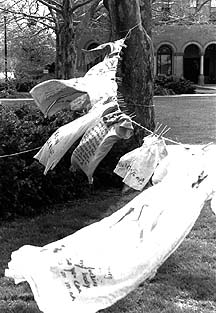









Yesterday the landscape of Wider Bowl looked different than on most spring days. A clothesline hung between two large trees and, as students walked by, they stopped to look at the shirts and dresses that had been painted with words and pictures. The clothes and the writing on them were a memorial to the survivors of sexual assault.
"The idea is [for the clothesline] to be a testimony to survivors of sexual assault," Devon Grayson, Sexual Assault Support Team (SAST) counselor, said. "It is touches you in a very personal way the same way a project like the AIDS quilt does."
"People put a lot of themselves in their shirts," Sarah Schoomer, senior and SAST counselor, said.
Counselor Karyn Brownson, a sophomore, said, "It is healing to make a physical object."
SAST sponsored its fifth annual Clothesline Project on Thursday as a part of Sexual Assault Awareness Month. Survivors of abuse, both male and female, were encouraged to decorate clothes in a private space in Wilder Hall, and a SAST counselor or the person donating the clothing hung them on the clothesline. Friends and relatives of victims were also encouraged to add to the project, as a way of remembering those victims who were not present or who did not survive.
The Clothesline Project is a national program that dates back to 1990. It was created as a way for survivors of sexual assault to bring their abuse into the public's view. It has become an international project, spreading to Bolivia in 1992, and to Tanzania, Costa Rica, England and many other nations in the following years.
Organizer Sarah Crow, a senior, said that the project is a way for "survivors, friends and partners to express how they are feeling and then leave it for other people to learn from."
Schoomer said that the visibility of the clothesline is a big part of the project. "The bigger issue is that it is something visible about a problem that is private and secretive. If it isn't an issue of your own, you may not know it exists," she said.
Regarding observers who are not survivor of assault, Crow said, "I think it really teaches them a lot. It challenges them to think about sexual assault. It is not possible to go by the clothesline and not be affected."
Counselor Rana Freedman, a sophomore, said, "I think one of the most important aspects is bringing awareness that rape happens at Oberlin. . . . It is too bad that [the clothesline] is just a small percentage of the survivors at Oberlin."
In addition to the clothesline itself, SAST counselors were available
Testimony:The Clothesline project in Wilder Bowl.(photo by Ariel Carter)

Copyright © 1996, The Oberlin Review.
Volume 124, Number 22; April 26, 1996
Contact Review webmaster with suggestions or comments at ocreview@www.oberlin.edu.
Contact Review editorial staff at oreview@oberlin.edu.